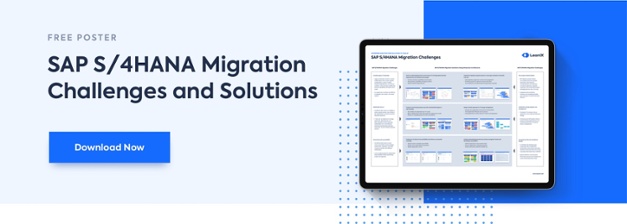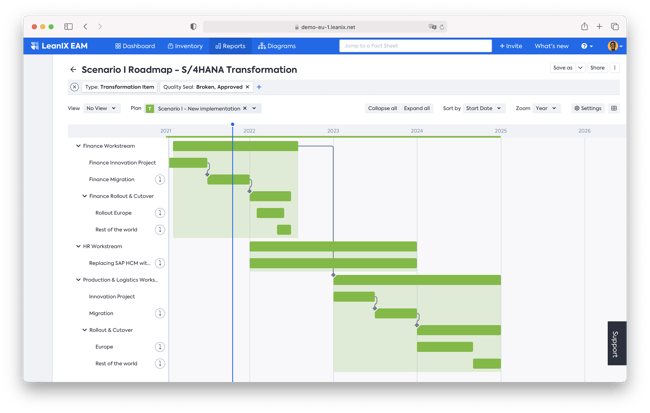Three approaches to S/4HANA transformation
Depending on what S/4HANA deployment option you decide on, there are two options to approach transformation: the Greenfield approach, which is starting from scratch, or upgrading SAP ECC 6.0 in a Brownfield approach, which allows the transformation without re-implementation and without disrupting existing business processes.
Some organizations opt for a hybrid approach, which lets you choose the best parts of Greenfield and Brownfield implementations. This approach is best for large enterprises with a lot of data and complex systems.
A short introduction to all three S/4HANA transformation approaches is explained below and in our detailed Greenfield vs. Brownfield approach comparison.
Greenfield approach - new implementation
If a company decides to adopt the Greenfield approach, it abandons its existing ERP system. This has the advantage that a new, uniform system can be implemented that only contains the processes and data that are actually necessary.
If a company completely redefines its enterprise architecture, innovations can also be integrated more easily and a high level of functionality can be achieved. In the study mentioned above, only 14 percent of all respondents chose this approach because it involves more effort.
However, when switching to the SAP S/4HANA cloud version, the Greenfield approach is unavoidable as the systems are completely replaced.
Brownfield approach - system conversion
With the Brownfield approach, a system conversion takes place. This means that existing business processes are taken over and optimized if necessary.
Since most companies do not want to completely abandon their custom ERP system, the Brownfield approach is the most popular migration path. According to the study, 44 percent of respondents choose this strategy, while 42 percent opt for a combined Greenfield and Brownfield variant.
To ensure a smooth transition, EA tools are used to divide the conversion into clear phases. The tools also ensure that old processes are rethought so that redundancies and complexity are not adopted. The advantage over the Greenfield approach is that the project time for system conversion is reduced.
Hybrid approach - selective data transition
Strictly speaking, the hybrid approach and its landscape transformation is not an independent transformation strategy. It is simply a method that large companies with complex system landscapes can use to prepare for transformation. In practice, this means that databases are cleaned up and consolidated to reduce the Footprint before the change.
Companies can also use this approach to combine several ERP systems from different vendors. Such a simplification is also possible during the actual transformation. Whether this makes sense depends on the system landscape and the target system. In many cases, an enterprise architect works with all three approaches to achieve the best possible approach.
How to choose the right SAP S/4HANA approach?
Before transitioning to SAP S/4HANA, a company has to make a few important fundamental decisions that influence the overall transformation strategy. For example, switching to SAP S4HANA Cloud System requires a different approach than switching to SAP S/4HANA On-Premise System.
Another crucial question is whether the existing SAP ECC system with its data and settings should simply be converted. In some cases, it may make sense to set up a completely new ERP system that will cause fewer problems in the future. In any case, a transformation requires good preparation and a transparent strategy that is understandable for all business areas and stakeholders.
| Objectives and Results |
Approach to take |
- SAP S/4HANA Cloud Transformation
- Simplified business processes
- Innovations integrated easier
- Takes more effort
|
Greenfield approach |
- Convert existing SAP ECC system with its data and settings
- Faster transformation
|
Brownfield approach |
- Combine several ERP systems from different vendors
- Transformation within large companies with very complex system landscapes
- Databases are cleaned up and consolidated
|
Hybrid approach |


/EN-WP-SAP-S4Hana-Migration-Resource_Page_Thumbnail.png?width=400&height=283&name=EN-WP-SAP-S4Hana-Migration-Resource_Page_Thumbnail.png)
.png?width=260&height=171&name=BTMPlaybook-FI%20(1).png)





